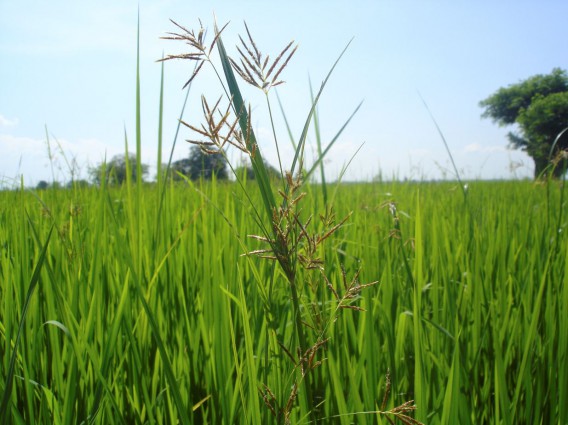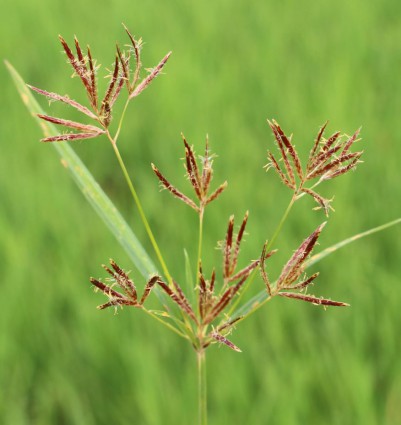
Photo by Dindo King Donayre
As they say, prevention is better than cure.
Researchers at Philippine Rice Research Institute (PhilRice) are studying the impact of the emergence of the world’s worst weed in irrigated lowland rice production. Cyperus rotundus L. or purple nutsedge also locally called as mutha, sudsud, and barsanga, which is previously known to grow only in the upland, is now quite prevalent in the lowland.
As mutha is considered the worst weed thriving in more than 90 countries and infesting more than 50 crops, researchers are conducting experiments to learn more about the lowland ecotype and discover its management options.
Before it became an agricultural menace, the weed was a source of food during the early civilizations. Microscopic evidence of C. rotundus had been found in human dental calculus collected in Al Khiday, a complex of five archaeological sites in Central Sudan dating before 6700 BC to the Meroitic pre-Islamic Kingdom in 300–400 AD. It is also suggested that the consumption of C. rotundus could have contributed to the low rate of dental decay among them because it can inhibit Streptococcus mutants, a bacterium that contributes to tooth decay. The weed has also been used as a traditional medicine in many countries.
In present day farming, Dindo King M. Donayre, PhilRice scientist, said that the weed can cause up to 42% yield loss in upland rice when left uncontrolled until harvest and in vegetable farms where flooding is not practiced.
Generally, weeds reduce rice yield from 44 to 96% as they compete with rice for nutrients, sunlight, and water.
Mutha is difficult to control owing to its extensive network of underground tubers that serves as means for propagation. Donayre said that herbicides only affect some of the tubers and do not shoot down the entire network.
“New networks of tubers and shoots grow from the remaining tubers; thus, creating an almost unbeatable life cycle,” he explained
Finding its way in the new rice ecosystem
Previous studies suggest that mutha does not thrive well in areas with abundant water such as in irrigated lowland. However, when planting rice and other crops in the wet season and dry season, respectively, became a common practice, mutha gradually emerge. The weed grow during the non-rice periods while the tubers remain dormant during the rice season due to water abundance.
Consistent with other experts, Donayre suggested that the weed developed new adaptive mechanism from its constant exposure in submerged environments; enabling its survival under water stress. Eventually, it evolved to live along side with rice.
Donayre’s study in 2005 in Aliaga, Nueva Ecija and data from Philippine Rice Information System confirmed the weed’s presence in other parts of the country.
“Data show that the weed is no longer location-specific. It’s also becoming a farmers’ problem because they apply herbicides to manage mutha,” Donayre said.

Photo by Dindo King Donayre
The upland and lowland mutha
Donayre said that the lowland ecotype has a new sense of survival. Based on initial findings, it can grow more than a meter than its upland counterpart. It also has larger diameter of stems and air spaces inside that give way for better survival under submerged condition.
The new ecotype has larger tubers, which means it can store more energy to survive even when under stress.
“Carbohydrates are sources of energy. The more it has, the chances to thrive are greater,” he said.
Discovering more about mutha
Donayre maintained that the effect of this new ecotype in irrigated lowland rice yield is yet to be fully explored.
“It’s existence is confirmed and there are already studies about its characteristics and processes. Our interest is more on practicality,” he said.
Initially, a pot experiment was conducted at PhilRice Central Experiment Station to determine the effects of a single plant mutha in the growth and development of rice under irrigated-lowland condition. Results of the study showed that a single mutha has no effect in both direct seeded and transplanted rice plants under 3 cm water level.
“We would also like to know at what density it can affect the rice plant. Or maybe it doesn’t have an effect at all. We can confirm if there’s a need to control the weed after these studies,” he said.
Simultaneously, studies are being conducted to identify the effects of existing weed management methods to the lowland mutha such as flooding. Results showed that mutha cannot develop new plants when submerged to water while still underground. However, it can thrive even under water when shoots are already above ground.
While studies are still ongoing, Donayre recommended the stale seedbed method in controlling mutha. The technique involves repeatedly ploughing the field during the fallow period to allow seeds and other parts of the weeds to grow. The new plants can then be killed later. It has been proven to effectively reduce the population of weeds.




